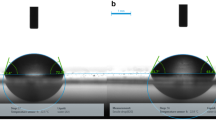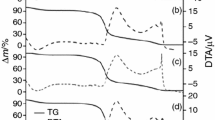Abstract
Effects of the combination of extrusion pretreatment and enzymatic hydrolysis on corn starch are investigated through its microstructural and physicochemical properties. This combined modification resulted in the formation of more pores on the surface of native starches (NS), as revealed by scanning electron microscopy (SEM). Compared with either single-treatment modified starch samples, starch that was bioextruded and treated by enzymatic hydrolysis achieved higher crystallinity, more uniform pore structure, and higher gelatinization temperature than those of native porous starch, as determined by X-ray diffraction (XRD), Fourier-transform infrared (FTIR), and differential scanning calorimetry (DSC). Low-temperature nitrogen adsorption experiments showed that the specific surface area (2.52 m2/g), total pore volume (4.53 × 10−3 cm3/g), and average pore size (7.36 nm) of porous starch were significantly increased by bioextrusion combined with enzyme hydrolysis (P < 0.05). The results of hydrolysis degree (DH) also showed that bioextrusion could improve the efficiency of hydrolysis. Starch that was bioextruded followed by enzyme hydrolysis showed the highest adsorption capacity in adsorption tests of adsorption of oil (63.29%), water (162.61%), and methylene blue (6.04%). The present study suggests that the combination of bioextrusion pretreatment and enzymatic hydrolysis is an attractive alternative for preparing porous corn starches.




Similar content being viewed by others
Abbreviations
- NS:
-
Native starch
- ES:
-
Extruded starch
- EES:
-
Bioextruded starch
- NPS:
-
Native starch followed by enzyme hydrolysis
- EPS:
-
Extruded starch followed by enzyme hydrolysis
- EEPS:
-
Bioextruded starch followed by enzyme hydrolysis
- AM:
-
Medium-temperature α-amylase
- AMG:
-
Glucoamylase
- SEM:
-
Scanning electron microscopy
- OAC:
-
Adsorption capacity
- MB:
-
Methylene blue
- SP:
-
Swelling power
- SOL:
-
Solubility
- XRD:
-
X-ray diffraction
- FTIR:
-
Fourier-transform infrared spectroscopy
- DH:
-
Hydrolysis degree
References
Aggarwal, P., & Dollimore, D. (1998). A thermal analysis investigation of partially hydrolyzed starch. Thermochimica Acta, 319(1–2), 17–25.
Akdogan, H. (1996). Pressure, torque, and energy responses of a twin screw extruder at high moisture contents. Food Research International, 29(5–6), 423–429.
Belingheri, C., Ferrillo, A., & Vittadini, E. (2015a). Porous starch for flavor delivery in a tomato-based food application. Lwt-Food Science and Technology, 60(1), 593–597.
Belingheri, C., Giussani, B., Rodriguez-Estrada, M. T., Ferrillo, A., & Vittadini, E. (2015b). Oxidative stability of high-oleic sunflower oil in a porous starch carrier. Food Chemistry, 166, 346–351.
Benavent-Gil, Y., & Rosell, C. M. (2017a). Comparison of porous starches obtained from different enzyme types and levels. Carbohydrate Polymers, 157, 533–540.
Benavent-Gil, Y., & Rosell, C. M. (2017b). Morphological and physicochemical characterization of porous starches obtained from different botanical sources and amylolytic enzymes. International Journal of Biological Macromolecules, 103, 587–595.
Bhatnagar, S., & Hanna, M. A. (1994). Extrusion processing conditions for amylose lipid complexing. Cereal Chemistry, 71(6), 587–593.
Chen, G., & Zhang, B. (2012). Hydrolysis of granular corn starch with controlled pore size. Journal of Cereal Science, 56(2), 316–320.
Chen, Y. S., Huang, S. R., Tang, Z. F., Chen, X. W., & Zhang, Z. F. (2011). Structural changes of cassava starch granules hydrolyzed by a mixture of alpha-amylase and glucoamylase. Carbohydrate Polymers, 85(1), 272–275.
Chung, H. J., Liu, Q., & Hoover, R. (2009). Impact of annealing and heat-moisture treatment on rapidly digestible, slowly digestible and resistant starch levels in native and gelatinized corn, pea and lentil starches. Carbohydrate Polymers, 75(3), 436–447.
Ciardullo, K., Donner, E., Thompson, M. R., & Liu, Q. (2019). Influence of extrusion mixing on preparing lipid complexed pea starch for functional foods. Starch-Starke, 71(7–8), 10.
Dura, A., Blaszczak, W., & Rosell, C. M. (2014). Functionality of porous starch obtained by amylase or amyloglucosidase treatments. Carbohydrate Polymers, 101, 837–845.
Gao, F., Li, D., Bi, C. H., Mao, Z. H., & Adhikari, B. (2013). Application of various drying methods to produce enzymatically hydrolyzed porous starch granules. Drying Technology, 31(13–14), 1627–1634.
Gatt, E., Rigal, L., & Vandenbossche, V. (2018). Biomass pretreatment with reactive extrusion using enzymes: a review. Industrial Crops and Products, 122, 329–339.
Guo, L., Liu, R., Li, X. L., Sun, Y., & Du, X. F. (2015). The physical and adsorption properties of different modified corn starches. Starch-Starke, 67(3–4), 237–246.
Jiang, T. Y., Wu, C., Gao, Y. K., Zhu, W. Q., Wan, L., Wang, Z. Y., et al. (2014). Preparation of novel porous starch microsphere foam for loading and release of poorly water soluble drug. Drug Development and Industrial Pharmacy, 40(2), 252–259.
Juszczak, L., Fortuna, T., & Krok, F. (2003). Non-contact atomic force microscopy of starch granules surface. Part I. Potato and tapioca starches. Starch-Starke, 55(1), 1–7.
Li, J. P., Jiao, A. Q., Deng, L., Rashed, M. M. A., & Jin, Z. Y. (2018). Porous-structured extruded instant noodles induced by the medium temperature—amylase and its effect on selected cooking properties and sensory characteristics. International Journal of Food Science and Technology, 53(10), 2265–2272.
Likhitkar, S., & Bajpai, A. K. (2012). Magnetically controlled release of cisplatin from superparamagnetic starch nanoparticles. Carbohydrate Polymers, 87(1), 300–308.
Lin, J. H., Pan, C. L., Singh, H., & Chang, Y. H. (2012). Influence of molecular structural characteristics on pasting and thermal properties of acid-methanol-treated rice starches. Food Hydrocolloids, 26(2), 441–447.
Ma, X. F., Liu, X. Y., Anderson, D. P., & Chang, P. R. (2015). Modification of porous starch for the adsorption of heavy metal ions from aqueous solution. Food Chemistry, 181, 133–139.
Man, J., Cai, C., Yan, Q., Hu, M., Liu, Q., & Wei, C. (2012). Applications of infrared spectroscopy in the analysis of ordered structure of starch grain. Acta Agronomica Sinica, 38(3), 505–513.
Miao, M., Zhang, T., & Jiang, B. (2009). Characterisations of kabuli and desi chickpea starches cultivated in China. Food Chemistry, 113(4), 1025–1032.
O’Shea, N., Arendt, E., & Gallagher, E. (2014). Enhancing an extruded puffed snack by optimising die head temperature, screw speed and apple pomace inclusion. Food and Bioprocess Technology, 7(6), 1767–1782.
Qian, J. Q., Chen, X. Y., Ying, X. X., & Lv, B. F. (2011). Optimisation of porous starch preparation by ultrasonic pretreatment followed by enzymatic hydrolysis. International Journal of Food Science and Technology, 46(1), 179–185.
Raphaelides, S. N., Dimitreli, G., Exarhopoulos, S., Ilia, E., & Koutsomihali, P. (2015). A process designed for the continuous production of starch inclusion complexes on an industrial scale. Food and Bioproducts Processing, 96, 245–255.
Román, L., Martínez, M. M., Rosell, C. M., & Gómez, M. (2015). Effect of microwave treatment on physicochemical properties of maize flour. Food and Bioprocess Technology, 8(6), 1330–1335.
Sevenou, O., Hill, S. E., Farhat, I. A., & Mitchell, J. R. (2002). Organisation of the external region of the starch granule as determined by infrared spectroscopy. International Journal of Biological Macromolecules, 31(1–3), 79–85.
Shariffa, Y. N., Karim, A. A., Fazilah, A., & Zaidul, I. S. M. (2009). Enzymatic hydrolysis of granular native and mildly heat-treated tapioca and sweet potato starches at sub-gelatinization temperature. Food Hydrocolloids, 23(2), 434–440.
Tatsumi, H., & Katano, H. (2005). Kinetics of the surface hydrolysis of raw starch by glucoamylase. Journal of Agricultural and Food Chemistry, 53(21), 8123–8127.
Thommes, M., Kaneko, K., Neimark, A. V., Olivier, J. P., Rodriguez-Reinoso, F., Rouquerol, J., et al. (2015). Physisorption of gases, with special reference to the evaluation of surface area and pore size distribution (IUPAC technical report). Pure and Applied Chemistry, 87(9–10), 1051–1069.
Wang, D. L., Ma, X. B., Yan, L. F., Chantapakul, T., Wang, W. J., Ding, T., et al. (2017). Ultrasound assisted enzymatic hydrolysis of starch catalyzed by glucoamylase: investigation on starch properties and degradation kinetics. Carbohydrate Polymers, 175, 47–54.
Wang, S. J., Wang, J. R., Zhang, W., Li, C. L., Yu, J. L., & Wang, S. (2015). Molecular order and functional properties of starches from three waxy wheat varieties grown in China. Food Chemistry, 181, 43–50.
Wlodarczyk-Stasiak, M., & Jamroz, J. (2009). Specific surface area and porosity of starch extrudates determined from nitrogen adsorption data. Journal of Food Engineering, 93(4), 379–385.
Wu, Y., Du, X. F., Ge, H. H., & Lv, Z. (2011). Preparation of microporous starch by glucoamylase and ultrasound. Starch-Starke, 63(4), 217–225.
Xie, Y., Li, M. N., Chen, H. Q., & Zhang, B. (2019). Effects of the combination of repeated heat-moisture treatment and compound enzymes hydrolysis on the structural and physicochemical properties of porous wheat starch. Food Chemistry, 274, 351–359.
Xu, E., Wu, Z., Long, J., Wang, F., Pan, X., Xu, X., et al. (2015). Effect of thermostable α-amylase addition on the physicochemical properties, free/bound phenolics and antioxidant capacities of extruded hulled and whole rice. Food and Bioprocess Technology, 8(9), 1958–1973.
Xu, E. B., Pan, X. W., Wu, Z. Z., Long, J., Li, J. P., Xu, X. M., et al. (2016). Response surface methodology for evaluation and optimization of process parameter and antioxidant capacity of rice flour modified by enzymatic extrusion. Food Chemistry, 212, 146–154.
Xu, E. B., Wu, Z. Z., Ding, T., Ye, X. Q., Jin, Z. Y., & Liu, D. H. (2019). Magnetic (Zn-St)Fe-10(n)0 (n=1, 2, 3, 4) framework of macro-mesoporous biomaterial prepared via green enzymatic reactive extrusion for dye pollutants removal. ACS Applied Materials & Interfaces, 11(46), 43553–43562.
Xu, E. B., Wu, Z. Z., Long, J., Jiao, A. Q., & Jin, Z. Y. (2018). Porous starch-based material prepared by bioextrusion in the presence of zinc and amylase-magnesium complex. ACS Sustainable Chemistry & Engineering, 6(8), 9572–9578.
Yan, X., Wu, Z. Z., Li, M. Y., Yin, F., Ren, K. X., & Tao, H. (2019). The combined effects of extrusion and heat-moisture treatment on the physicochemical properties and digestibility of corn starch. International Journal of Biological Macromolecules, 134, 1108–1112.
Yao, W., & Yao, H. (2005). Researches on porous starch II the changes of physical characteristics during porous starch formation. Journal of the Chinese Cereals and Oils Association, 20(1), 17–21.
Ye, J. P., Hu, X. T., Luo, S. J., Liu, W., Chen, J., Zeng, Z. R., et al. (2018). Properties of starch after extrusion: a review. Starch-Starke, 70(11–12), 8.
Yu, S., Ma, Y., Menager, L., & Sun, D.-W. (2012). Physicochemical properties of starch and flour from different rice cultivars. Food and Bioprocess Technology, 5(2), 626–637.
Zhang, B., Cui, D. P., Liu, M. Z., Gong, H. H., Huang, Y. J., & Han, F. (2012). Corn porous starch: preparation, characterization and adsorption property. International Journal of Biological Macromolecules, 50(1), 250–256.
Zhang, B. J., Li, X. X., Liu, J., Xie, F. W., & Chen, L. (2013). Supramolecular structure of A- and B-type granules of wheat starch. Food Hydrocolloids, 31(1), 68–73.
Zhao, A. Q., Yu, L., Yang, M., Wang, C. J., Wang, M. M., & Bai, X. (2018). Effects of the combination of freeze-thawing and enzymatic hydrolysis on the microstructure and physicochemical properties of porous corn starch. Food Hydrocolloids, 83, 465–472.
Zhu, J. J., Sun, Y. B., Sun, W. Z., Meng, Z. Y., Shi, Q. L., Zhu, X. X., et al. (2019). Calcium ion-exchange cross-linked porous starch microparticles with improved hemostatic properties. International Journal of Biological Macromolecules, 134, 435–444.
Acknowledgements
This study was supported by the National “Thirteenth Five-Year” Plan for Science & Technology Support of China (No.2016YFD0400304), Jiangsu Agriculture Science and Technology Innovation Fund (CX(17)2022), the Science & Technology Pillar Program of Jiangsu Province (BE2018304), and Jiangsu Key Laboratory of Advanced Food Manufacturing Equipment & Technology (FM-201904). The authors thank Dr. Ding Kang and Dr. Lei Shi for valuable discussions.
Author information
Authors and Affiliations
Corresponding author
Additional information
Publisher’s Note
Springer Nature remains neutral with regard to jurisdictional claims in published maps and institutional affiliations.
Electronic supplementary material
ESM 1
(DOCX 4674 kb)
Rights and permissions
About this article
Cite this article
Wu, W., Jiao, A., Xu, E. et al. Effects of Extrusion Technology Combined with Enzymatic Hydrolysis on the Structural and Physicochemical Properties of Porous Corn Starch. Food Bioprocess Technol 13, 442–451 (2020). https://doi.org/10.1007/s11947-020-02404-1
Received:
Accepted:
Published:
Issue Date:
DOI: https://doi.org/10.1007/s11947-020-02404-1




